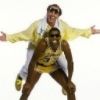Starting last season, the Los Angeles Lakers began testing out a new way to better track the health and performance of their players. To do so, they culled data from multiple devices and methods and fed it into a formula that charted the players in green, yellow or red zones. As you'd expect, green is good, yellow is caution and red is bad.
"So we’re going to take average speed, we’re going to multiply the distance, we’re going to multiply that by their body weight -- average speed times distance times body weight,” says Lakers head trainer Gary Vitti. “That’s going to give us a number that we call ‘load.’
“Then we’re going to take the load and we’re going to divide that by the minutes that the player played and that’s going to give us another number that we call ‘intensity.’
“So theoretically, you want a direct linear relationship between load and intensity. As the load is going up, you want intensity to go up with it. And as long as that’s happening, we put that player in the green zone, meaning we can keep pushing him. If load is going up, and intensity is starting to flatten, then he’s going into the yellow zone and now he has our attention. What do we need to do? He’s starting to flatten, his performance is going down, he’s not moving as efficiently. If load is going up and intensity is starting to tank, now you’re in the red zone and we’ve got to do something.”
Three years ago, some of their summer-league players wore Catapult's biometric vests designed to monitor players' workloads with the goal of maximizing performance while minimizing injury risk. But they've kicked it up a notch of late.
This offseason the Lakers began using a pulse oximetry device by Masimo that uses infrared light to gauge inflammation levels, hydration levels, the oxygen in their blood and more. Players insert an index finger into the device once in the mornings, and then again during and between interval bouts of work, for about two minutes before a reading appears. Vitti says the technology is typically used by anesthesiologists.
The Lakers also use an online psychomotor vigilance test to measure reaction time.
On direct application with respect to Ryan Kelly's injury:
"We could've identified those two guys in the red zone. For sure, we could've. Ryan Kelly, absolutely, 100 percent, for sure," Vitti says. "But it happened so quickly. And we were in the first year with Byron [as head coach] so we had no idea what he was going to do the first day. So very early in the second practice, Ryan already broke down. That particular injury really caused us to step this up a notch."
They're still aggressively pursuing the latest technology to help, as well.
The Lakers are in talks with a company called Plantiga about placing microchips in players' sneakers.
"This is probably, in my opinion, if this is valid and reliable, it may be the most single useful thing of all the s--t that we're doing," Vitti says.
"If you can imagine getting true foot-to-ground information, whether it's ground contact time -- so if you're getting tired, your foot is going to spend more time on the ground," says DiFrancesco, whom Vitti, a fellow New Englander, helped bring into the Lakers' organization five years ago. "I could have my iPad knowing that this player and this player are well below their ground contact time while they're on the practice floor. That information in real time could be utilized."
The Lakers are also in talks with a company called dorsaVi for wearable sensors, roughly the size of a quarter. A player could wear several - four seems likely -- and the specific sensors -- ViPerform -- record data at 200 frames per second.
Baxter Homes - ESPN
Baxter Holmes - ESPN
Looks like this is part of the new transparency effort the Buss family is promoting to give the fans an inside view of how franchise is not exactly shunning science and analytics efforts that's been prevalent in the NBA.









 +
+  =
= 
























